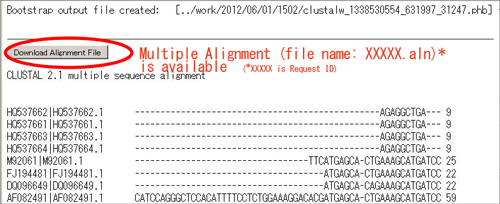
Important note: This tool can align up to 4000 sequences or a maximum file. For the alignment of two sequences please instead use our pairwise sequence alignment tools. Clustal Omega is a new multiple sequence alignment program that uses seeded guide trees and HMM profile-profile techniques to generate alignments between three or more sequences.
It combined a memory-efficient dynamic programming algorithm (2) with the progressive alignment strategy developed by Feng and Doolittle (3) and Willie Taylor.Conserved regions: In biology, during the evolutionary time there may be some regions called group of bases or a sequence of nucleotides preserved as such in DNA, those sequences or a region, if seen in next generations called as Conserved regions.Consensus Sequence: In a Nucleotide or an amino acid sequence, each base pair (an amino acid or a nucleotide) may occur more frequently at a particular region in different sequences of nature.Sequence is a collection of nucleotides or amino acid residues which are connected with each other. To align three or more sequences to find out structural and functional relationship between these sequences.Whats new in ClustalX 2.1: Fixed bug 196 'clustalx: user feedback about use of secondary structure printed to console' - secondary structure is now used if specified in Alignment -> Alignment Parameters -> Secondary Structure Parameters UserParameters->getGui() should be used when ClustalW. In addition, clustalx enables its users to choose between existing color sets or.
The 3' end of the primer accomodates the dideoxy nucleotides (specific to each tube) as well as deoxy nucleotides randomly. Next a primer is to be added which anneals to one of the strand in DNA template. Into each of the test tubes, DNA has to be added in denatured form (single strands). Similarly Edman Degradation method and Mass Spectrometry technique are used for protein sequencing.Sanger Method (dideoxy chain termination method): Here 4 test tubes are taken labelled with A, T, G and C. Most commonly used methods for DNA sequencing are Sanger Method and Maxam-Gilbert Method. There are different experimental methods for sequencing, and the obtained sequence is submitted to different databases like NCBI, Genbank etc.Sequences stored in the database were obtained from different experimental methods.
Clustal 2 Series Of Labeled
Electrophoresis technique helps in arranging the fragments based on their molecular weight. This fragment is then subjected to purification before proceeding for chemical treatment which results in a series of labeled fragments. The primer or one of the nucleotides can be radioactively or fluorescently labeled also, so that the final product can be detected from the gel easily and the sequence can be inferred.Maxam-Gilbert (Chemical degradation method): This method requires denatured DNA fragment whose 5' end is radioactively labeled. Electrophoresis is done and the sequence order can be obtained by analysing the bands in the gel based on the molecular weight. Thus small strands of DNA are formed.
Since it is believed that, a sequence sharing a common ancestor would exhibit similar structure or function. Based on the mass to charge ratio, one can identify the amino acids in a protein.When a new sequence is found, the structure and function can be easily predicted by doing sequence alignment. After each clevage, chromatography or electrophoresis is done to identify the amino acid.Mass Spectrometry: It is used to determine the mass of particle, composition of molecule and for finding the chemical structures of molecules like peptides and other chemical compounds. A series of dark bands will appear, each corresponding to a radio labeled DNA fragment, from which the sequence can be inferred.Edman Degradation reaction: The reaction finds the order of amino acids in a protein by cleaving each amino acid from the N-terminal without distrubing the bonds in the protein.
Through this, we can easily identify the most evolutionarily conserved regions that play critical role in functionality of a specified gene.During the evolutionary time, the genes may have got altered at sequence level, which results in alteration of function. The genes which are similar may be conserved among different species.Take these identical or similar set of genes to perform multiple sequence alignment. Alignment of three or more biological nucleotides or protein sequences, simply defines multiple sequence alignment.
Because of such limitations with dynamic programming, researchers came up with an approach called 'progressive method' to align three or more sequences.Progressive method was first suggested by Feng and Doolittle in 1987. But this program is limited to pair wise, since there will be exponential increase in memory, number of steps with respect to number of sequences. The same approach can be used for alignment of ‘n’ number of sequences. It would be helpful in getting new domains or motifs with biological significance.We can find many tools for multiple sequence alignment like MSA DIALIGN, CLUSTAL series, MAFT, MUSCLE, T-Coffee, BlastAlign, etc.Table 1: Summary of multiple sequence alignment programs*Adapted from Current Opinion in Structural Biology 2006, 16:368–373.Pair wise sequence alignment has been approached with dynamic programming between nucleotide or amino acid sequences.

Calculate a guide tree based on the pairwise distances (algorithm: Neighbor Joining). Calculate all possible pairwise alignments, record the score for each pair. Recently a newer version of CLUSTALW came out with the name CLUSTAL Omega which is available from the European Bioinformatics institute Higgins D has written the first program of CLUSTAL, considering memory and time various CLUSTAL series of programs have came up and presently used version is CLUSTALW, which came up with dynamic programming and progressive alignment methods.CLUSTALW uses the progressive algorithm, by adding the sequence one by one until all the sequences are completely aligned. CLUSTALW is one among the mostly accepted tool. Where it helps to guide the alignment of sequence- alignment and alignment –alignment.Multiple sequence alignment can be done through different tools. The gap symbols in the alignment replaced with a neutral character.
Replace the two sequences with the consensusIii. Calculate a consensus of this alignmentIi. Align the sequences by progressive methodI.
Expand the consensus sequences with the (gapped) original sequences6. Iterate until all sequences have been aligned5.


 0 kommentar(er)
0 kommentar(er)
